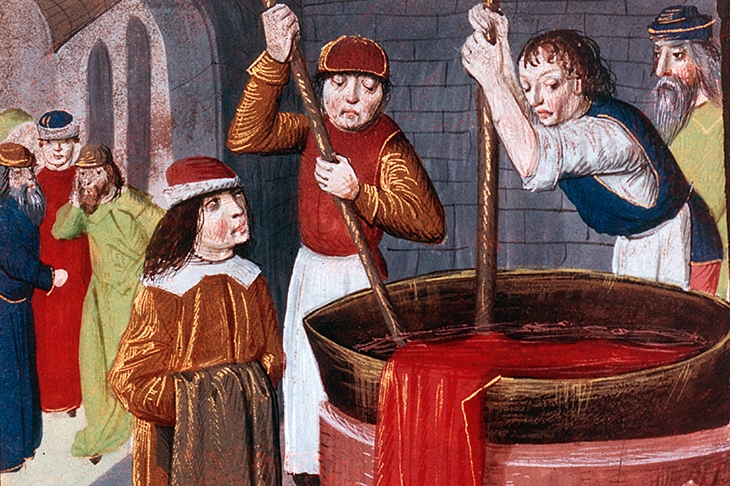Liza Picard, an chronicler of London society across the centuries, now weaves an infinity of small details into an arresting tapestry of life in 14th-century England. Her technique — pursued with the verve and spirit for which she is already justly admired — is to celebrate Chaucer’s pilgrim portraits by resituating them within an enlarged field of medieval practices and assumptions.
Geoffrey Chaucer’s own trick, in enlivening the portraits with which he launches his Canterbury Tales, is the epitomising detail, the apparently random observation — in current poker language, the ‘tell’ — that gives the pilgrim’s game away. He zooms in on the Knight’s rust-stained tunic, the Prioress’s pampered lapdogs, the Summoner’s skin disease, the Pardoner’s long and stringy hair. Picard has her own sharp eye for lively detail but goes in the other direction: less to selection than to amplification, attending to the wider field of assumption, observation, tradition and fact within which Chaucer’s choices resonate.
Take the Cook, for example. Chaucer tells us several of his attainments, adds some of his devious kitchen practices and notices — provocatively and tellingly — that he has an open sore, or mormal, on his shin. Picard begins by glossing some of his dubious techniques — explaining, for example, the culinary risk in consuming meat pies ‘that hath been twice hot and twice cold’.
But she does not stop there, moving on to tell us about the Guild of Cooks,the apprenticeship of a medieval cook, the design and equipage of medieval kitchens, the uses of mortars and skimmers, the application of poetic recitation and church bell peals to judge cooking times, the availability of hired or public ovens, the toughness of medieval chickens, the infusion of wine by straining it through hanging spice bags, and much more.
Then, for good measure, she gives us 45 almost-kitchen-ready recipes from a 14th-century cookery book, including one of the Cook’s own specialities: a mixed meat stew. Here it is, in her partially modernised version of the English of the time:
Take the flesh of hens and pork and hewe it small, and grind it all to dust. Take grated bread . . . and temper [mix] it with the same broth, and thicken it with yolks of eggs, and cast thereon power fort [a strong prepared mixture of spices]. Boil it and do therein powder of ginger, sugar, saffron and salt . . . And flour it with powdered ginger.
By the same principle of expansion, the introduction of the Host leads to discussions of medieval stews or brothels, the differences between inns, taverns, and alehouses, the penalties for selling bad wine, and the likely topics of medieval tavern talk.
The Physician elicits descriptions of medieval scrofula and cure by royal touch; the Black Death; the remedies of the celebrated (and possibly legendary) female physician Trotula; together with a compendium of vivid and popular medieval cures, all with Picard’s friendly warning not to try them at home.
The Miller sparks a discussion of watermills vs windmills; the gearing needed to convert the vertical force of a waterwheel into the horizontal energy needed to rotate a millstone; the cost and source of good millstones and the best way to renew worn grooves; and the physical strength required of a good miller. The consequence of all this added — and engaging — detail is not to dilute or compromise Chaucer’s own carefully honed descriptions but, rather, to foster an appreciation of what may be called his ‘field of choice’, the palette of observed, and written, materials at his literary disposal.
The book adds unanticipated rewards. One is a table assessing the 14th-century cash equivalents of different items and services. Here’s one price point:
3d would buy a rabbit without the skin, a wild mallard, a woodcock or a plover. It was the daily pay of an unmounted archer in the 1350s, and a gardener and a sailor in 1387. It was the weekly toll on carts bringing sand and gravel, or corn and flour, into London.
A whole social history lurks in such details.
Picard concludes with a speculative Chaucer continuation. Readers of the Canterbury Tales know that its pilgrims never reach the shrine. Chaucer’s work ends with the pilgrims on the outskirts — stranded in a state of expectation and desire. Although devout yearnings have their own privileged status in medieval Christian devotion, readers have inevitably speculated about how the pilgrims might have conducted themselves at the shrine which they, or at least some of them, were seeking.
Picard does not shirk this challenge. Most notably, she — a woman who has herself lived long and thought much — creates an inner monologue for the Wife of Bath, who, after visiting the shrine, drifts into a Molly Bloomian soliloquy, reflecting on the pros, cons, and possible personal advantages of taking the veil. As in the rest of the book, we here encounter not presumption but homage, an enthusiast enacting her respect for Chaucer’s enduring and indelible accomplishment.





Comments